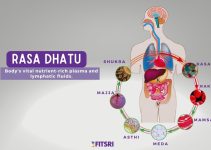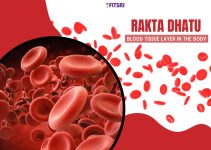
According to Ayurveda, there are 3 doshas that make up our physical and mental bodies. They are the Vata, Pitta, and Kapha. These three doshas are made up of a combination of 5 elements – fire, water, earth, air, and ether (or space).
Out of tri doshas, the Vata Dosha lays the foundation of the basic systems of our body i.e. movement. Without movement, the body will only be a mass of flesh and bones. The movement of neurotransmitters, blood, and oxygen to all body parts is essential to keep yourself healthy and working.
In this article, we will discuss Vata dosha in detail.
What is Vata Dosha?

The word Vata essentially means “wind”. The other meaning of Vata is “air”, “blow” or “move like a wind”. Thus the Vata Dosha is an “air dosha”, which is made of air and ether (space).
Vata dosha is said to be the foundation of our well-being. If vata dosha is in balance then you can expect the other two doshas – Pitta and Kapha – to work well.
The Vata Dosha is responsible for the movement of the body and mind. Any flow or movement within our body and mind such as blood and oxygen flow, muscle and bone movement, elimination of waste from the body, breathing, neurological movements in the brain, etc. are governed by the Vata dosha.
On a mental level, it also helps an individual’s cognitive abilities to understand things and maintain a mental balance and sensory harmony.
So from the blinking of your eyes to the movement of your toes, are being controlled by Vata dosha. Not only that Vata dosha is also able to move Pitta and Kapha dosha. Hence, it is also called the King of all Doshas.
Vata has the following qualities:
- Cold
- Dry
- Light
- Rough
- Mobile/Moving
- Subtle
- Quick
- Changeable
- Brittle
The Vata Dosha is mostly dominant during old age, between late fall to winter. Also, the 3rd hour after eating and time between 2 am – 6 am and 2 pm -6 pm should be taken into consideration. This is also one of the reasons it is said to be an early riser, to keep your Vata in balance.
Types of Vata Dosha
In the human body, vata dosha is present everywhere, from the top of the head to the toes. It reaches each body part through blood circulation, which is done by the heart, and through oxygen flow done through lungs and blood vessels. It helps in the elimination of waste through the digestive tract and urinary tract.
It is also helping in managing your thoughts nervous system and brain activities. Your throat, mouth, lips, skin, and other body parts are also affected by movement and sensory touch.
It is safe to say that typically, Vata dosha is all-pervading. However, it is also classified into 5 broad categories – Prana Vata, Udana Vata, Vyana Vata, Samana Vata, and Apana Vata.
1. Prana Vata is present in the brain, heart, and lungs. Prana is the essential life force that controls the body mechanics needed for survival. It is responsible for breathing, sneezing, belching, swallowing food, willpower, sensing, intellect, vision, etc.
2. Udana Vata is primarily located in the chest and moves through the throat and navel. This Vata governs speech, strength, vitality, breathing, enthusiasm, energy, and effort.
3. Vyana Vata is located in the heart. It is responsible for circulation, locomotion, heart rhythm, and muscle activity. The vyana vata moves from the heart to all other parts of the body.
4. Samana Vata is present in the liver, stomach, and intestines. It governs what should be eliminated from the body and what should stay inside. It keeps the Prana and Apana in balance.
5. Apana Vata can be found between the navel and anus. Any downward movement such as urination, defecation, menstruation, sexual discharges, childbirth, etc.
Symptoms of imbalanced Vata Dosha

As the Vata dosha is comprised mainly of the air element, any issues related to bloating, gas, and breathing, are more prevalent. A high Vata can make you lose the connection between the prana, mind, and body, causing a loss of coordination.
The Vata dosha is also prone to imbalances than the other two doshas. Hence irrespective of your constitution, you need to keep the Vata element in balance at one point.
Have a look at these signs of an unbalanced Vata
- Bloating, gas
- Dryness of skin, hair, ears, lips, joints
- Constipation, dehydration
- Weight loss
- Restlessness, dizziness, feeling ungrounded
- Headache, fatigue, loss of strength
- Insomnia, light sleep
- Poor circulation
- Asthma, pain and aches,
- Anxiety, Nervousness, panic, fear
- Fidgeting, agitation, muscle twitching, palpitations, muscle spasm
- Joint pain and muscle stiffness or cramps
- Difficulty tolerating loud noises
- Spacey, scattered feeling, confused
- Excess thinking or worrying
What does a Vata body look like?
The Vata people are famous for having small and thin bodies. They will either be tall or unusually short with a quick but unsteady gait. Their skin is dull and dry with some oily regions. They have a thin faces with small eyes, thin and dry hair, and thin eyebrows. Such people have dry or hoarse voices.
Vata people usually have dry tissues and the alimentary tract (the organs through which the food gets swallowed, digested, absorbed, and leave the body) problems. This is the reason why they make crackling sounds from their joints, loud breathing, belching and flatulence sound, etc.
They can easily get tanned and have cold hands and feet.
Unless they are tired, they will have irregular sleep and will get up often during the night. They experience bursts of energy but will suddenly feel fatigued. They possess irregular appetites and sensitive digestion due to which they lack the ability to preserve energy. Since they talk and move a lot, it is not easy for them to gain weight.
The Vata people are moody and have a short attention span. However they are very engaging, imaginative, creative, great learners, highly energetic, flexible, and like taking initiative.
They do not prefer cold or dry climates, loud noise, wind, and get easily irritated, anxious and frightened.
In short, they are the complete opposites of Kapha people.
What are the causes of Vata Dosha Imbalance?
We have seen the list of imbalances that can happen to a Vata person but what causes those imbalances? It is important to have the knowledge to avoid these interruptions.
The causes are as follows:
- Dry, cool, heavy foods
- Irregular and restless sleep
- Cold, dry and windy climate
- Excessive body movements such as walking, jumping, swimming, running or other exercises
- Stress, anxiety, work pressure, emotional imbalance, cold behavior, grief
- Over-analysis
- Excessive fluid elimination due to discharge or bleeding
- Constipation or diarrhea
However, if you work towards keeping your Vata in balance, you will be mentally alert, have enthusiasm in life, experience normal elimination, will have a sound sleep, have proper circulation with easy respiration, and normal tissue formation.
Tips to balance the Vata Dosha
As Vata dosha also works as the foundation for the pitta and Kapha dosha, it becomes necessary to keep it in balance. A balanced Vata dosha is vital for all our energy systems to work properly.
Here are a few tips to keep the Vata in balance.
- Eat freshly prepared warm food.
- Do not use excessive oil. Use liberal sesame oil, ghee, butter, olive oil, and coconut oil.
- Eat foods that are naturally sweet, salty, and sour in nature.
- Fruits that are beneficial – bananas, avocados, mangoes, apricots, plums, berries, coconut, figs, grapefruit, oranges, lemons, melons, papaya, peaches, pineapples, rhubarb, kiwi, dates, nectarines, and dried fruits.
- Include warm spices such as ginger, cinnamon, black pepper, cumin, cardamom, fennel, cloves, sage, turmeric, saffron, etc.
- Rice, whole wheat, quinoa, oatmeal are best.
- Avoid raw and gas-forming vegetables. Beans, broccoli, black beans, chickpeas, kidney beans, and vegetables with seeds should be avoided.
- Most varieties of nuts are allowed to be consumed.
- For non-vegetarian people, chicken, turkey, seafood, and eggs are recommended.
- Alcohol, nicotine, caffeine, chocolate should be avoided.
- Pumpkin, sweet potato, beets, carrots and zucchini, Brussel sprouts, avocados, dates, figs, lemons, limes, papayas, grapefruit, and grapes are beneficial.
- During dry seasons, stay hydrated with warm water.
- Create a routine and stick to it such as eating three meals a day, sleeping before 10 pm.
- Exercise in moderation. You can go for exercises that are soothing, gentle, and calming in nature such as walking in nature, yoga, or meditation.
- Surround yourself with people who are physically affectionate.
Also read: 7 Yoga poses, pranayama and meditation for Vata dosha
Conclusion
To make sure that your body is working at its optimum level, take care of your Vata dosha and keep it in balance. Having warmth surrounding you in terms of people, food, or climate will bring stability to your life. If your Vata is in balance, it will be easy for you to work with your other doshas as well.





Thank you
Very informative, I believe this is helpful
Comprehensive article. Does one’s “Swabhav and Sanskars” play a role why one is Vata or Kapha ?
Thanks.
thanks for this
Good tips sir ,these tips help for us